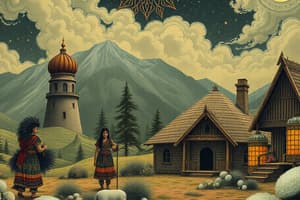Podcast
Questions and Answers
What were some of the primary adaptations made by the Inuit to survive in the Arctic environment?
What were some of the primary adaptations made by the Inuit to survive in the Arctic environment?
- Hunting large mammals and building igloos (correct)
- Using horses for transportation and gathering fruits
- Farming and trading with neighboring tribes
- Constructing log cabins and fishing in rivers
Why did the Sioux heavily rely on buffalo?
Why did the Sioux heavily rely on buffalo?
- For food, shelter, and tools (correct)
- For agricultural practices and irrigation
- For trade with European settlers
- For protective clothing against winter
Which factor contributed to the differences among Native American tribes?
Which factor contributed to the differences among Native American tribes?
- The dominance of a single cultural group
- The influence of European languages
- Their contact with European settlers
- The diverse climates and resources in their regions (correct)
What is one benefit of the 'tipi' design for nomadic Sioux tribes?
What is one benefit of the 'tipi' design for nomadic Sioux tribes?
What role did the Columbian Exchange play in Native American populations?
What role did the Columbian Exchange play in Native American populations?
What was one way Bartolomé de Las Casas aimed to help Native Americans?
What was one way Bartolomé de Las Casas aimed to help Native Americans?
How did geography influence the culture of the Anasazi people?
How did geography influence the culture of the Anasazi people?
What motivated Europeans to explore the New World?
What motivated Europeans to explore the New World?
Flashcards
Bering Land Bridge
Bering Land Bridge
The theory that the first indigenous people of the Americas migrated from Asia during the last Ice Age, using a land bridge that connected Siberia and Alaska.
Columbian Exchange
Columbian Exchange
The exchange of plants, animals, diseases, and ideas between the Old World (Europe, Asia, and Africa) and the New World (the Americas) after Christopher Columbus' voyages.
Longhouse
Longhouse
A type of dwelling traditionally used by the Iroquois in North America. It was a long, rectangular house built from wooden poles, bark, and other materials. They typically housed several families.
Adaptation
Adaptation
Signup and view all the flashcards
Nomad
Nomad
Signup and view all the flashcards
Tipi
Tipi
Signup and view all the flashcards
Bartolomé de Las Casas
Bartolomé de Las Casas
Signup and view all the flashcards
Natural Resources
Natural Resources
Signup and view all the flashcards
Study Notes
Quiz Information
- Format: Multiple choice, matching, and written response (ACE format)
- Date: Tuesday, September 24th, 2024
- Administration: In class, on Chromebook or paper. Whole period if needed.
- Important Information: Chromebook must be charged before class. Inform teacher of any device issues.
Key Vocabulary
- Geography
- Climate
- Bodies of water
- Natural resources
- Elevation
- Vegetation
- Landforms
- Bering Land Bridge
- Adaptation
- Arctic
- Eastern Woodlands/Northeast
- Pacific Northwest
- Southwest
- Southeast
- Great Plains/Midwest
- Inuit
- Sioux
- Anasazi
- Iroquois
- Longhouse
- Dwelling
- Nomad
- Bartolomé de Las Casas
- Columbian Exchange
- Christopher Columbus
Key Questions to Consider
- Why did anthropologists believe the first Native Americans migrated from Asia to America?
- Why were all Native American tribes so different?
- In what ways did the Sioux use the buffalo?
Additional Study Points (from second page)
- How did the Anasazi adapt their food to the Southwest climate?
- Why is a "tipi" beneficial for a nomadic lifestyle?
- What were some ways the Inuit adapted to their Arctic environment?
- Why did some Native American populations decrease after contact with Europeans?
- Why did Europeans want to go to the new world? (3 reasons)
- How did Europeans justify taking land from Natives?
- How did Columbus treat Natives?
- What were some consequences of European Exploration in the Americas?
- Writing Prompt: How did geography impact the culture of two Native American tribes? (Specific criteria for success are provided)
Studying That Suits You
Use AI to generate personalized quizzes and flashcards to suit your learning preferences.




